
The Bottom Line
Introduction, Specifications, and Pricing
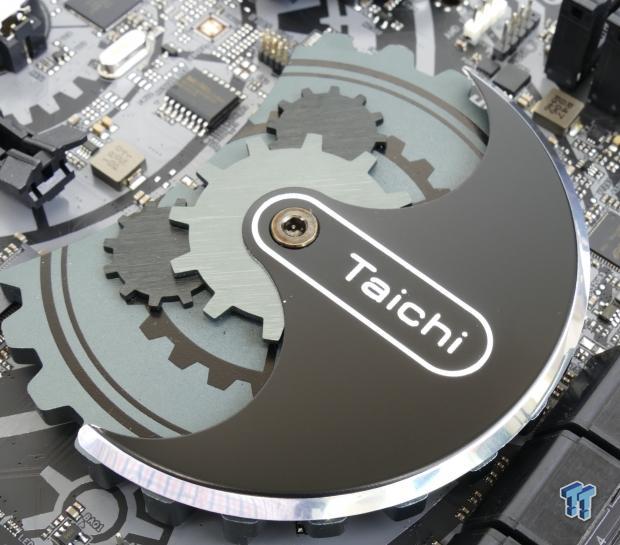
Today we take a look at ASRock's X470 Taichi motherboard, one of the brands better known and widely enjoyed SKUs. In fact, we reviewed the Taichi Ultimate version with more high-end features, and today we are looking at a motherboard that costs roughly $60 less with a similar feature set. Both of the Taichi models offer up RGB, but their heat sink and cover colors are opposite of each other. Let's see what the X470 Taichi has to offer.
Specifications

The X470 Taichi features dual M.2 slots, WIFI, Intel LAN, USB 3.1, and SATA6Gb/s.
Pricing
The X470 Taichi costs $209.99
Packaging and X470 Taichi Overview
Packaging and Overview
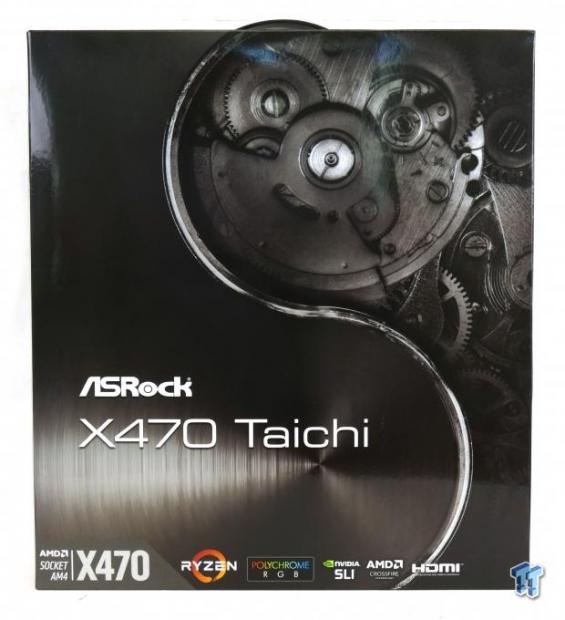
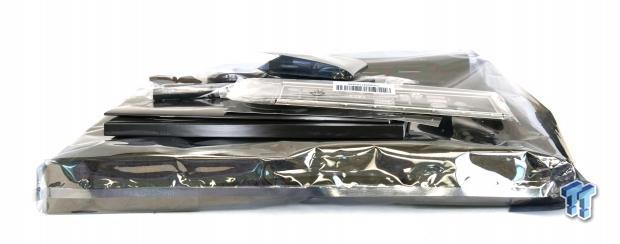
That box shot shows off the brushed steel look embedded within the box art. Packaging is top notch; the motherboard is well protected inside a foam motherboard tray.
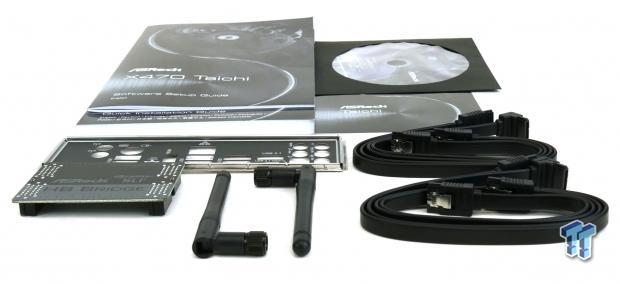
The accessory package includes four SATA6Gb/s, SLI HB Bridge, WIFI antenna, IO shield, case badge, postcard, driver DVD, and manual.
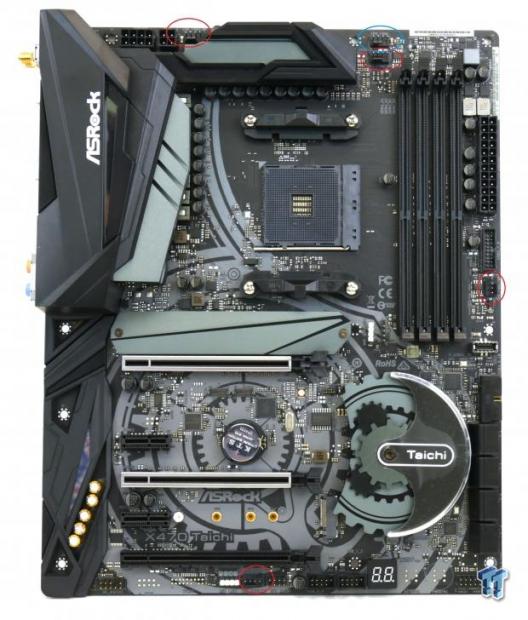
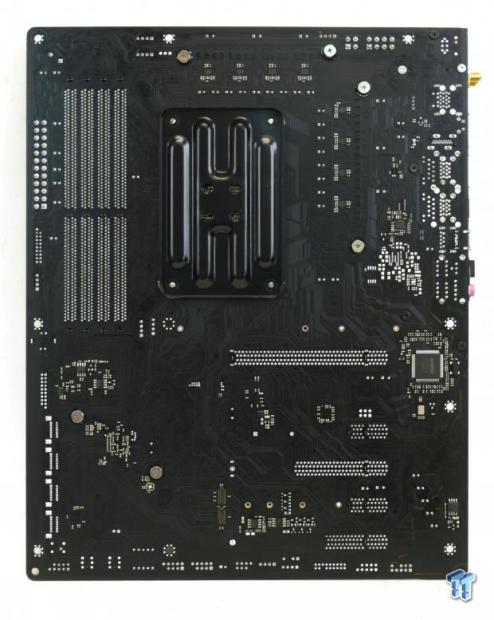
ASRock put in five fan headers and has renamed four out of the five headers as /WP headers, which means they also double as water pump headers. The headers with /WP offer up to 2A of current, while the one header circled in blue is rated for 1A. All the headers circled in red can operate as PWM or DC mode headers, but the header in blue is PWM by default as it's meant for a CPU fan. The motherboard offers a sleeker aesthetic appeal, with a unique PCH heat sink and shields over the audio and IO panel. The rear of the motherboard isn't bare of ICs but has a few.
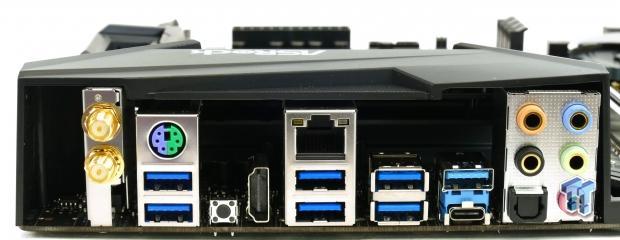
The rear IO panel features clear CMOS button, WIFI antenna outputs, PS/2 keyboard/mouse, six USB 3.0 ports (ports 5 and 6 offer Ultra USB Power), USB 3.1 type-A, USB 3.1 type-C, 1Gbit LAN (red), HDMI, and 7.1 gold-plated audio outputs with S/PDIF out.
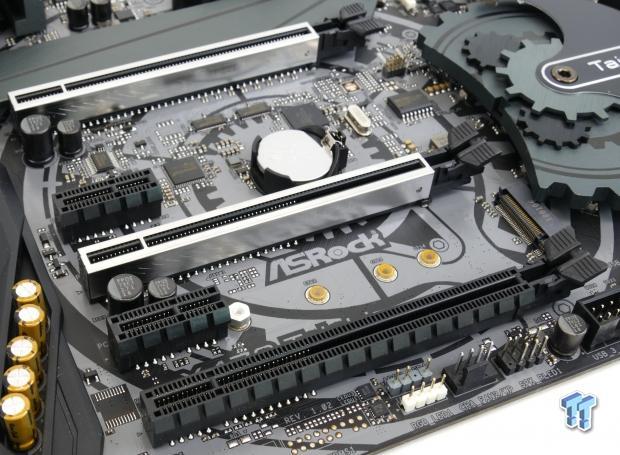
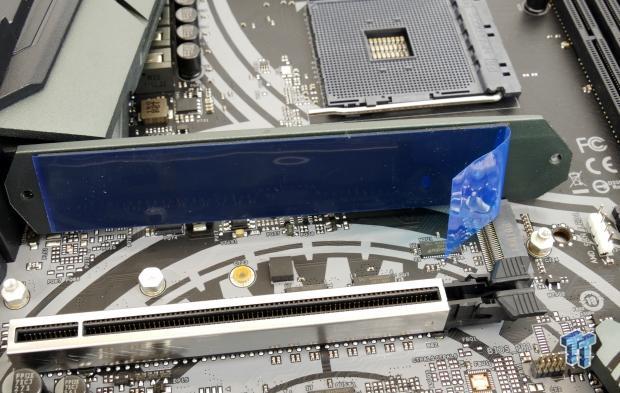
The PCI-E layout is simple; the top two x16 slots operate at x16/x0 or x8/x8 PCI-E 3.0 from the CPU. The PCI-E 2.0 x1 slots are linked to the PCH through a hub (which also provides for the WIFI/SATA). The last x16 slot is electrically x4 PCI-E 2.0 and shares all its bandwidth with the second M.2 slot. The top M.2 slot offers an x4 PCI-E 3.0 link and provides a heat sink.
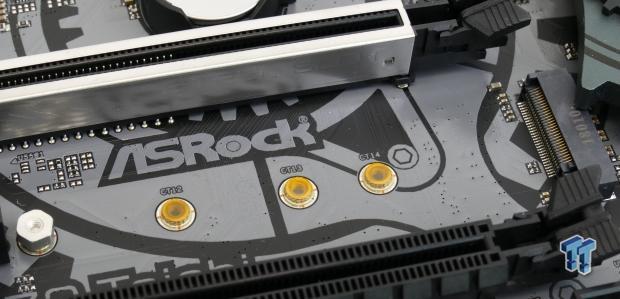
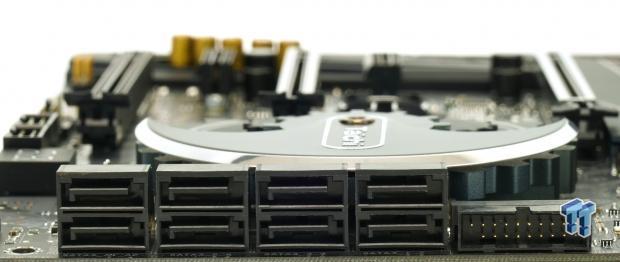
The bottom M.2 slot shares x4 PCI-E 2.0 with the last PCI-E 2.0 x16 slot. There are two extra SATA6Gb/s ports from an ASMedia chip, with the other six coming from the chipset. There is also a USB 3.0 internal header at a right angle near the SATA ports.
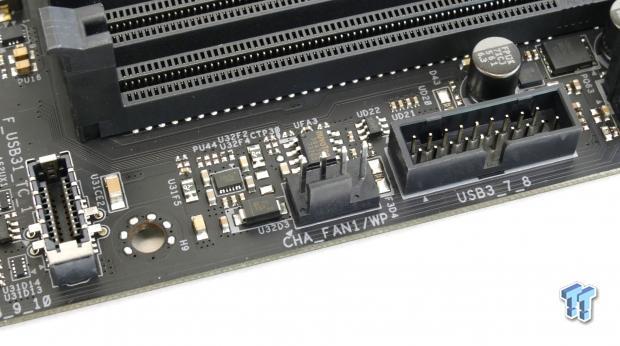
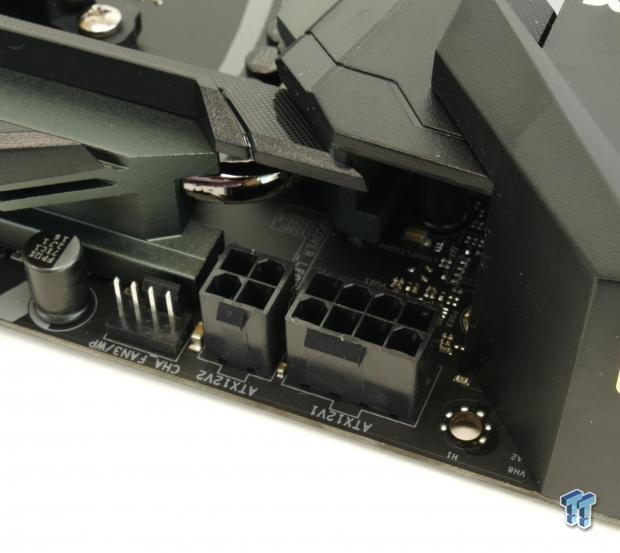
Right below the 24-pin power connector is a USB 3.0 internal header and a USB 3.1 type-C header. At the top right of the motherboard, we find the 8-pin CPU power header and a 4-pin power header for extra power.
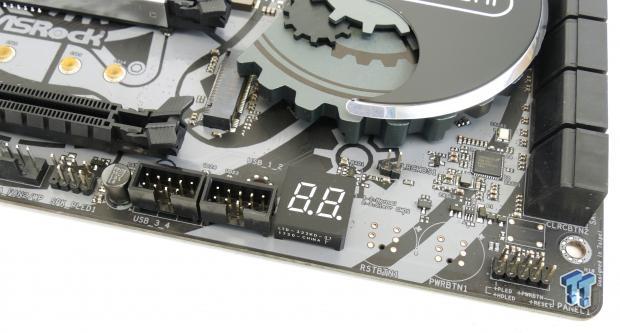
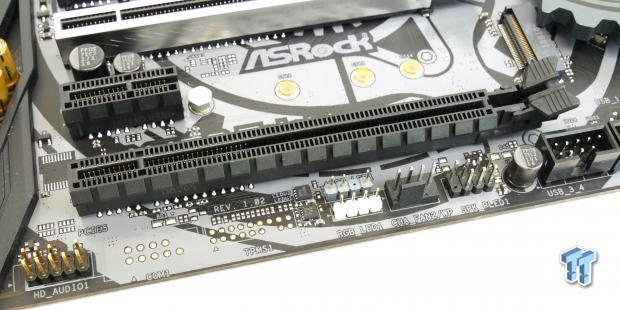
At the bottom right corner of the motherboard is the POST code display and front panel headers. There are two USB 2.0 internal headers at the bottom of the motherboard as well as more front panel headers. There is also an RGB LED header and an addressable RGB LED header.
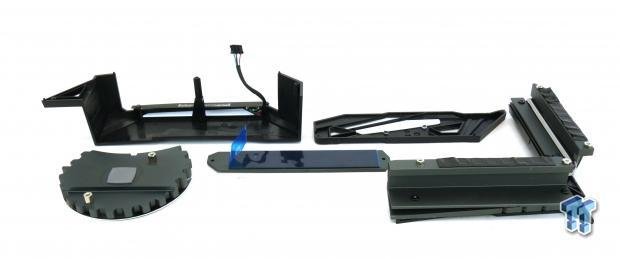
Heatsinks are all screwed down onto the motherboard.
ASRock X470 Taichi Circuit Analysis
Circuit Analysis

The X470 Taichi shows us the goods with the heat sinks removed!
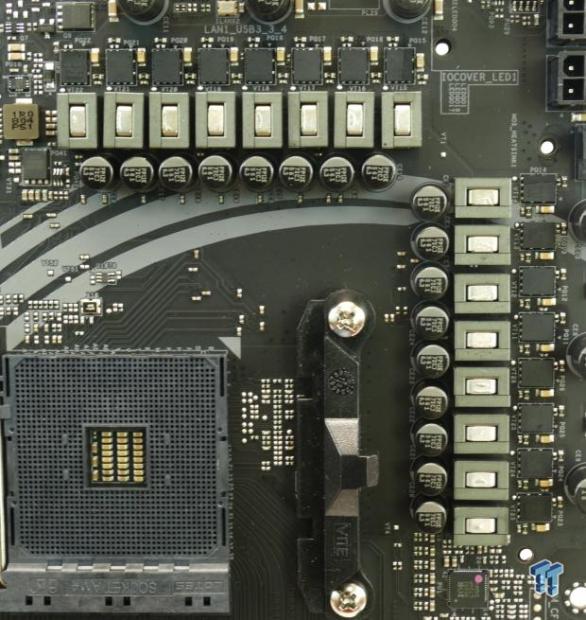
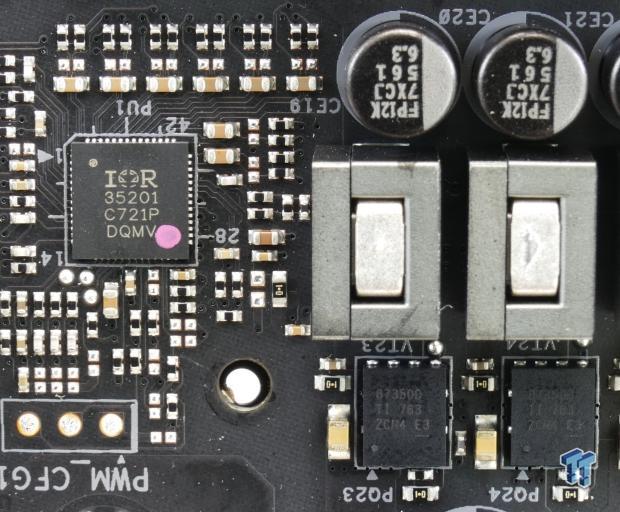
We see the VRM here is in a 12+4 phase mode and uses the IR35201 in 6+2 phase mode. The digital PWM from International Rectifier is used to its maximum, and each power stage consists of a 60A inductor as well as a Texas Instruments CSD87350 NexFET rated for 25A each. These NexFETs are some of the finest dual N-channel MOSFETs, and while we typically see dual N-channels from Fairchild, Sinopower, or even ON Semi it's nice to see the Texas Instruments variant here.
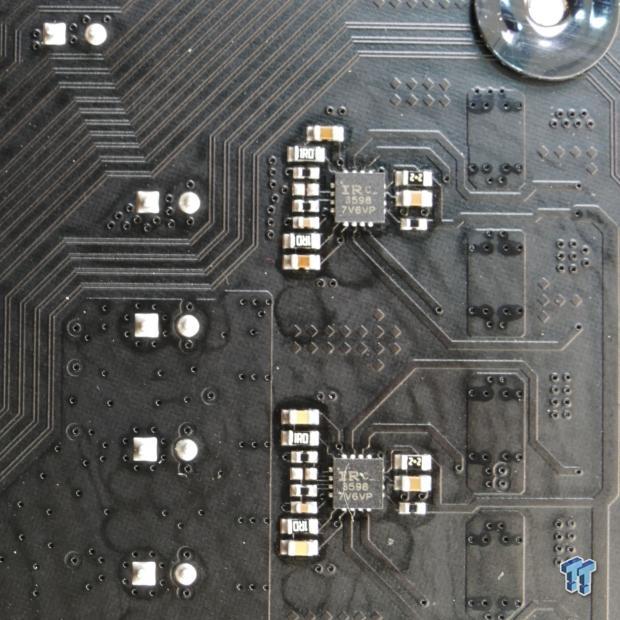
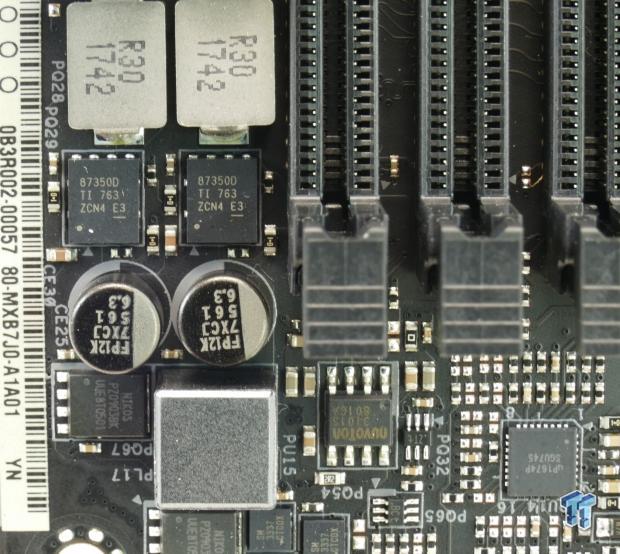
Those 6+2 phases from the PWM controller are doubled to 12+4 by eight IR3598 phase doubler plus integrated driver chips meant for this very purpose. The memory PWM is the UPI uP1674P, and the dual phases utilize the Texas Instruments 25A NexFETs.
ASRock X470 Taichi Circuit Analysis Continued
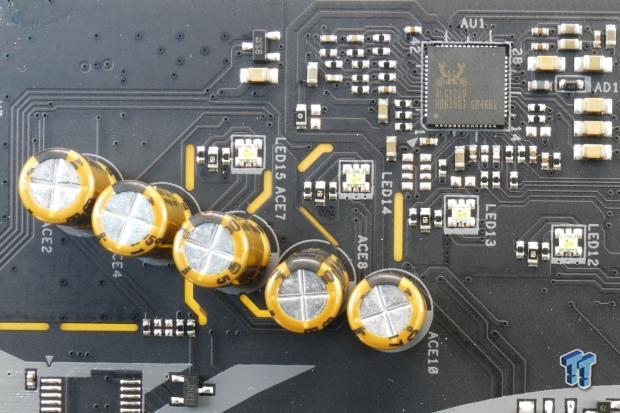
The audio section uses the Realtek ALC1220, and amplifier on the back of the motherboard, and five Gold series electrolytic audio capacitors, as well as a physical PCB, divide to improve audio quality.

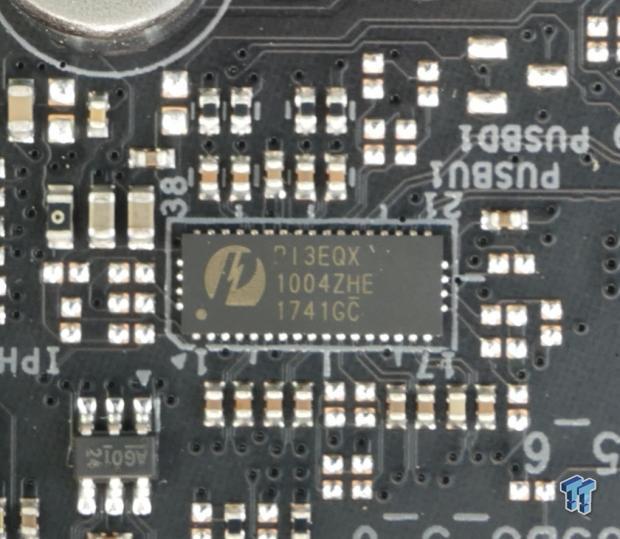
The Intel i211AT is used as the 1Gbit Intel NIC on the rear IO. The rear IO's USB 3.1 needs to be re-driven, and the Pericom PI3EQX is the re-driver that does this.
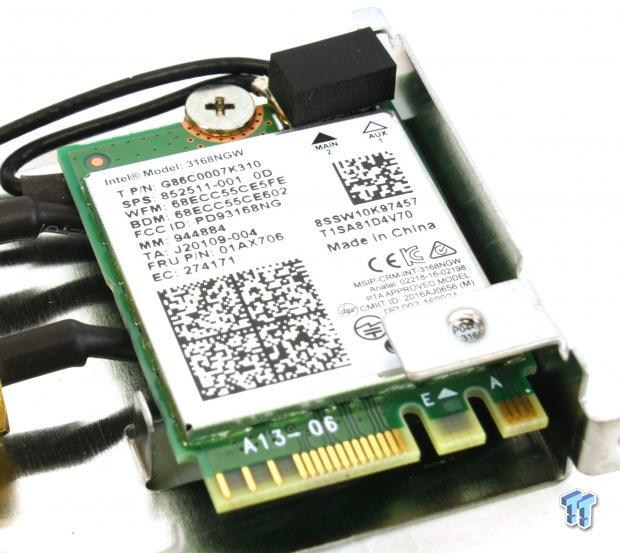
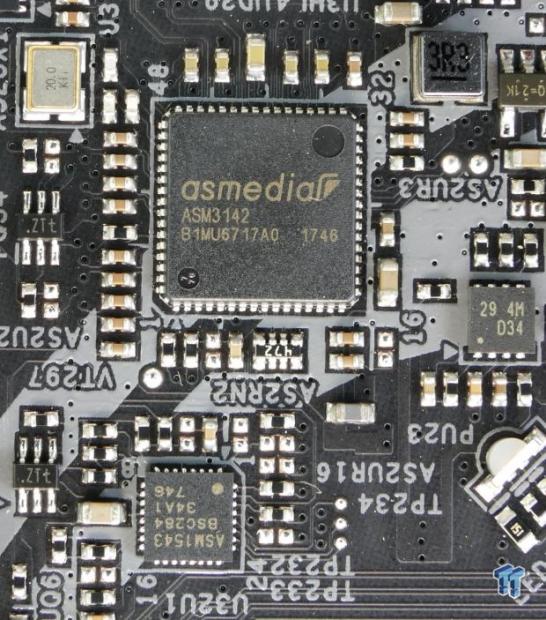
The Wireless AC is provided by the Intel Wireless AC 3168NGW 1x1 433Mbps card. The internal USB 3.1 header comes from an ASMedia ASM3142 controller and uses an ASMedia ASM1543 type-C controller.
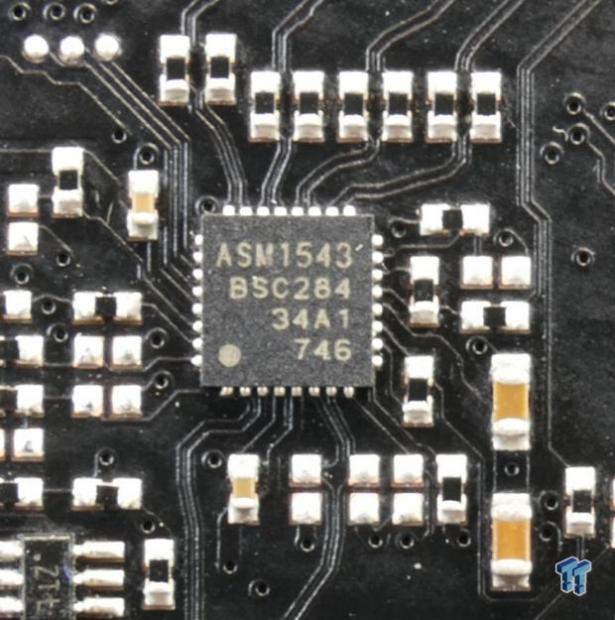
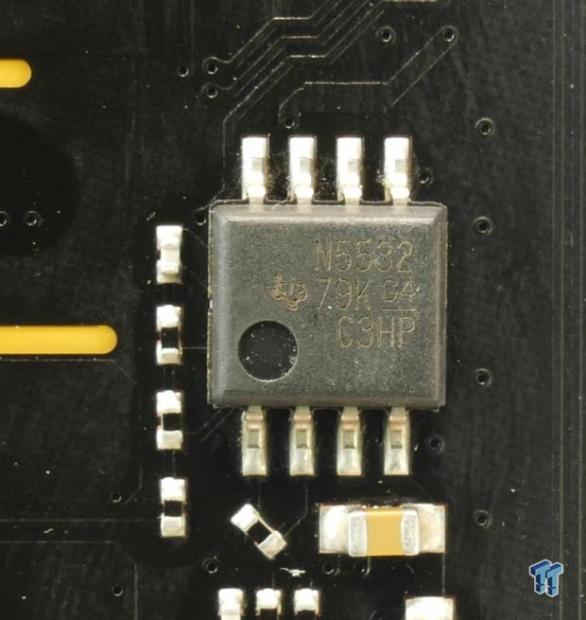
Another ASMedia ASM1543 type-C switch can be found on the back of the PCB near the rear IO area. The audio section uses a NE5532 audio amplifier for the front panel output.
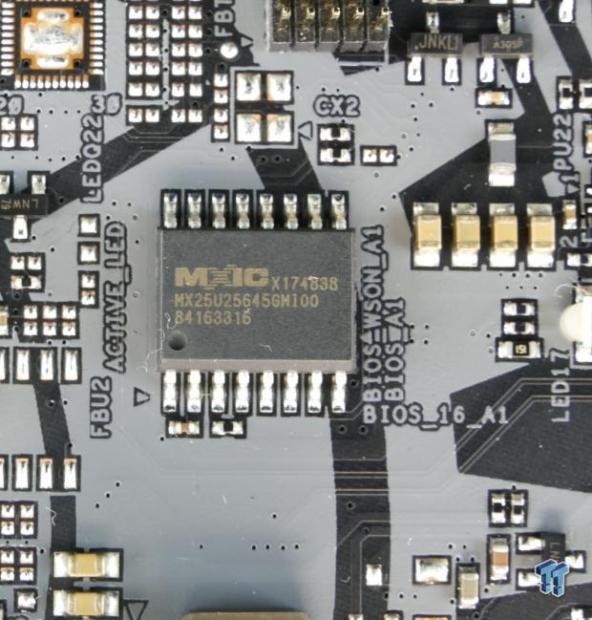
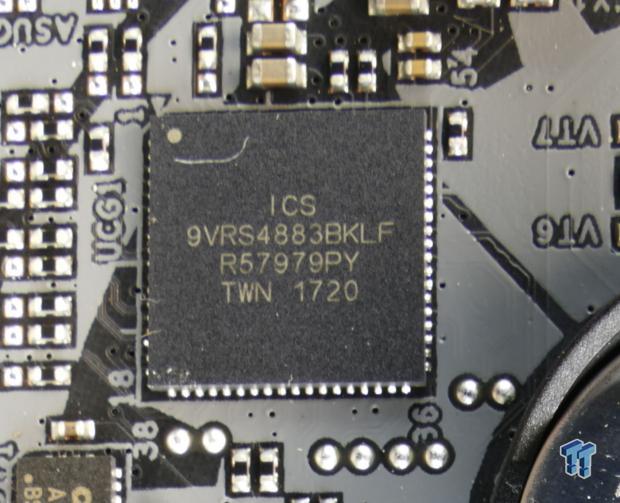
We find a 256Mbit BIOS ROM on the motherboard, which is double what is required. It's probably there for extra features for the BIOS or support of future hardware. There is an ISC 9CRS4883BKLF clock generator to try and help with the base clock overclocking on the motherboard.
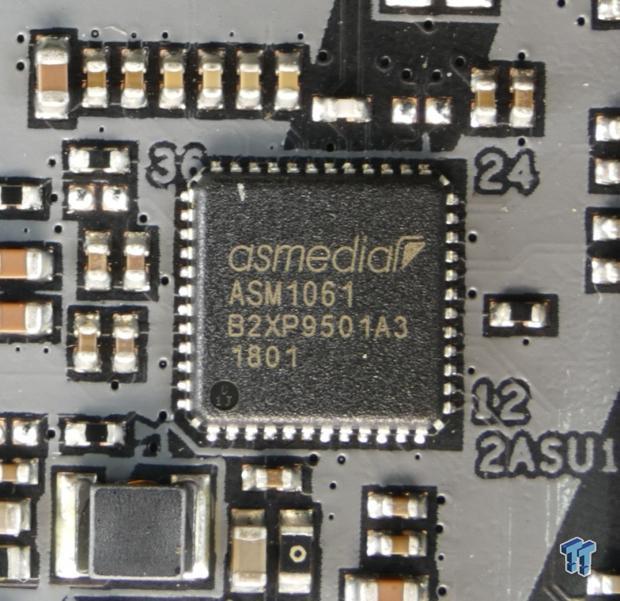
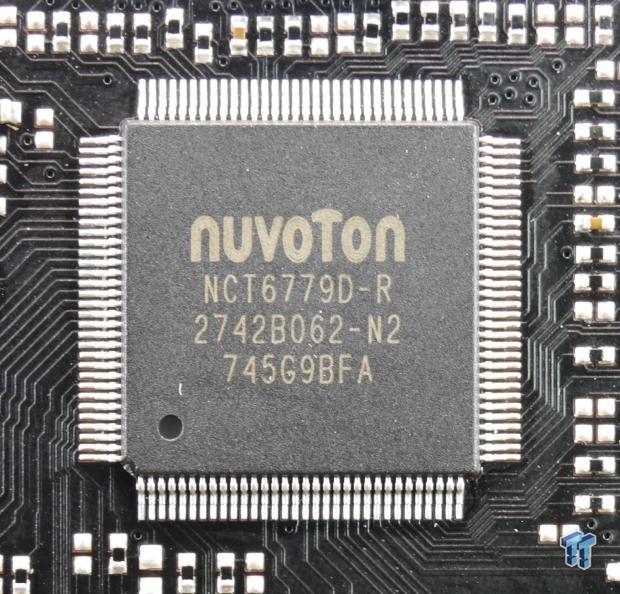
An ASMedia ASM1061 is used to add two SATA6Gb/s ports. A NuvoTon NCT6779D SuperIO is present on the motherboard for system management.
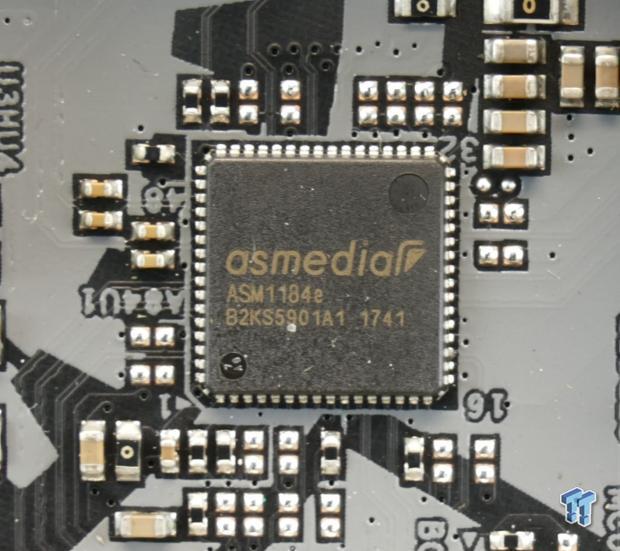
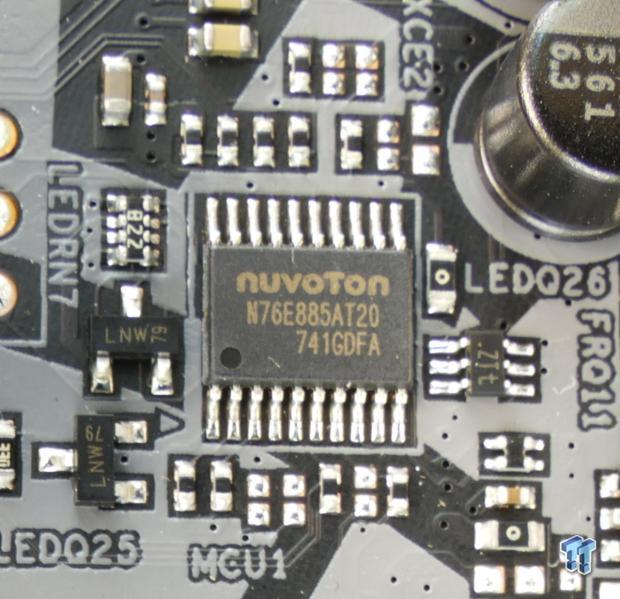
An ASMedia ASM1184e PCI-E hub takes in one PCI-E 2.0 lane and outputs four more to the two x1 slots, the WIFI controller, and the ASMedia SATA6Gb/s controller. The nuvoTon N76E885AT20 is an MCU used for RGB LED control.
BIOS and Software
BIOS
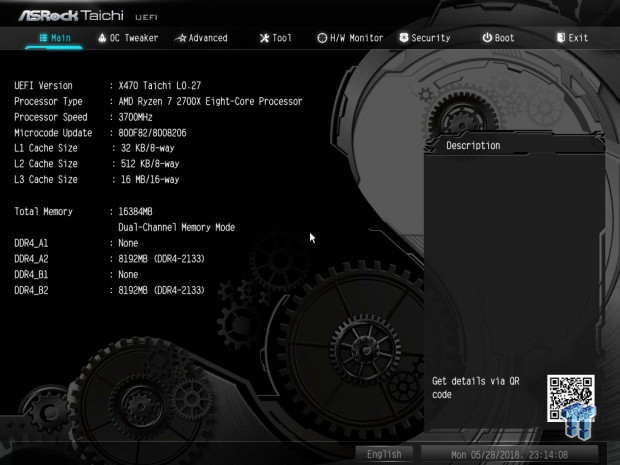
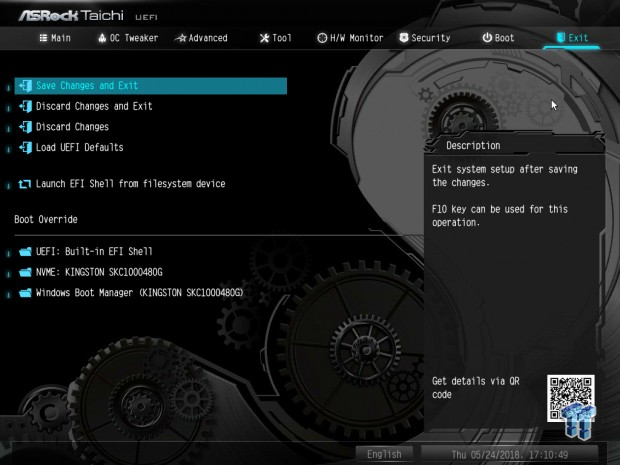
The UEFI for the ASRock X470 Taichi is similar to that of ASRock's other motherboard in both the color scheme and menu layout. One thing that seems to be new is the ability to choose between standard AMD overclocking menu and ASRock's OC setting menu. We used ASRock's to overclock and had no trouble, and it was similar to what we might consider AMD's mode. We like the integrated fan control as well in the form of GUI and manual input. The UEFI also can control some basic RGB LED settings.
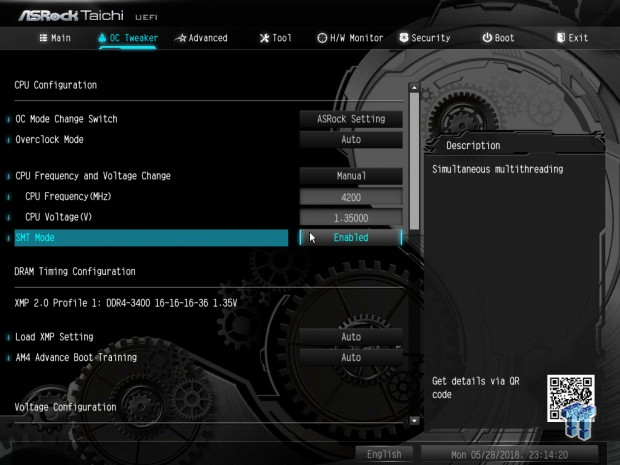
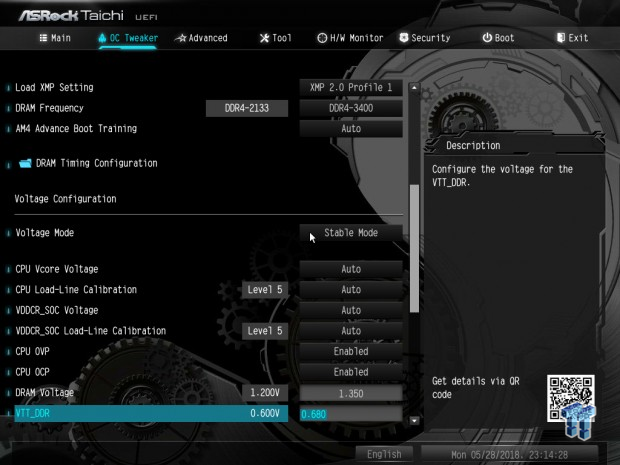
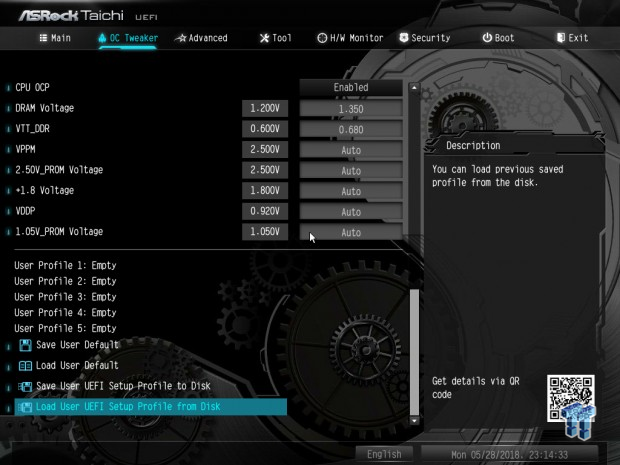
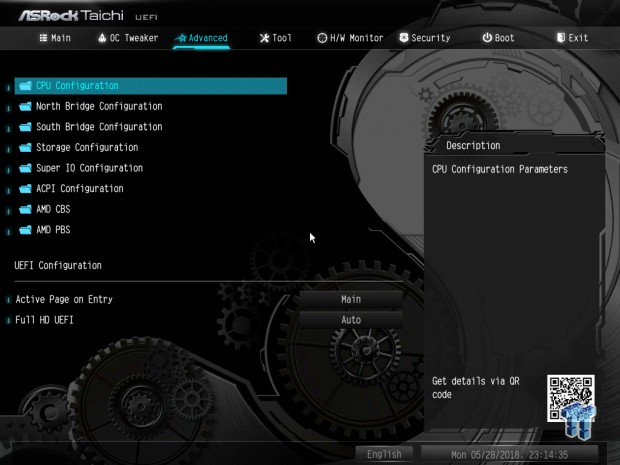
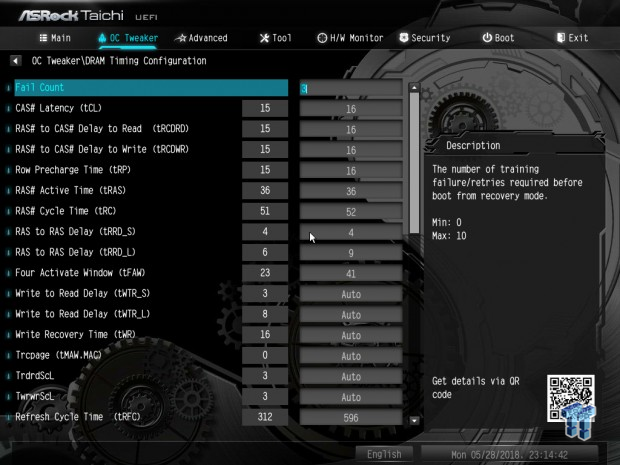
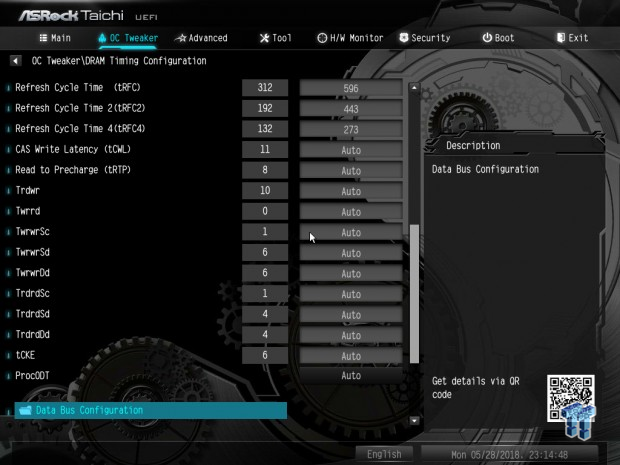
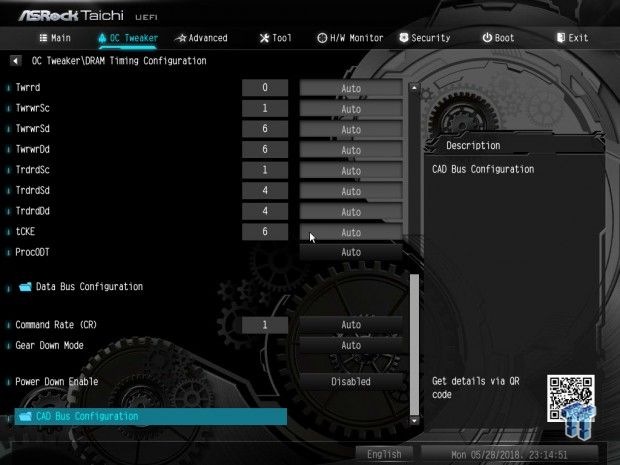
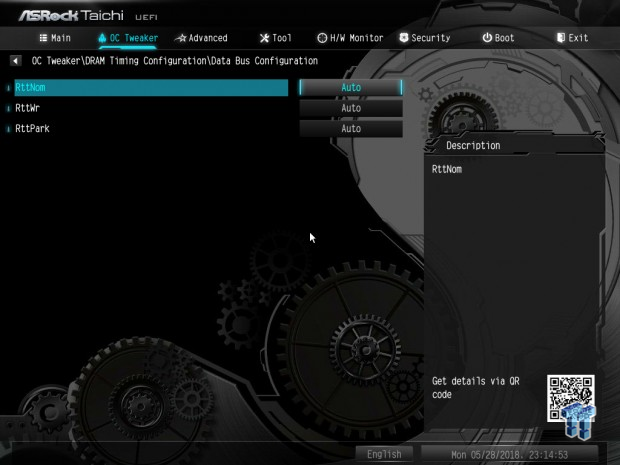
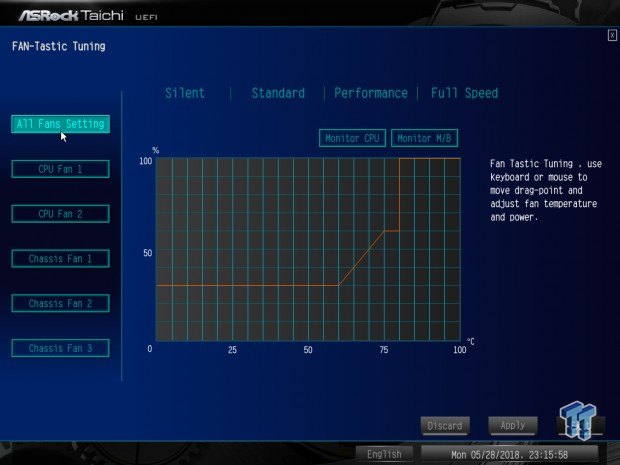
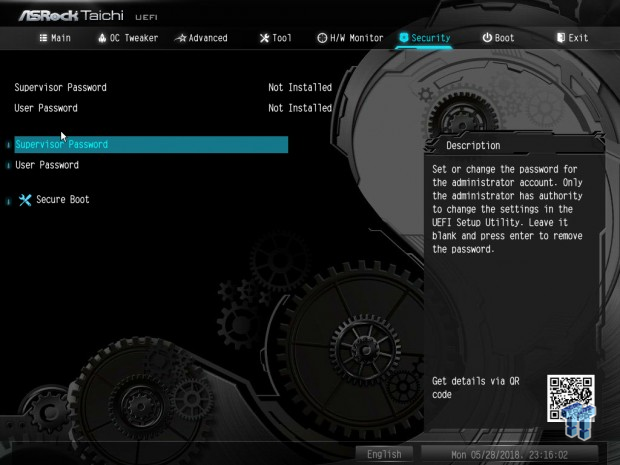
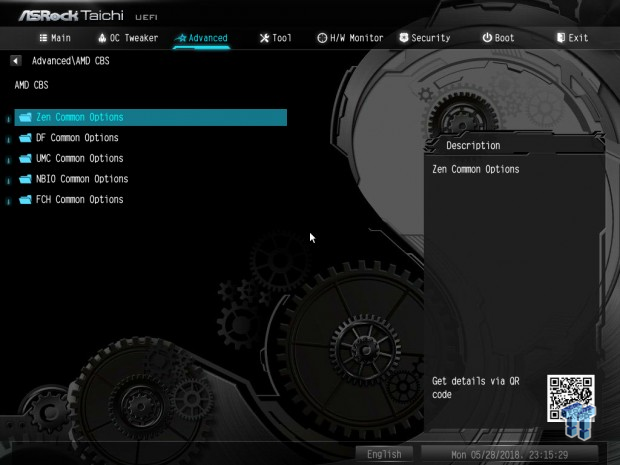
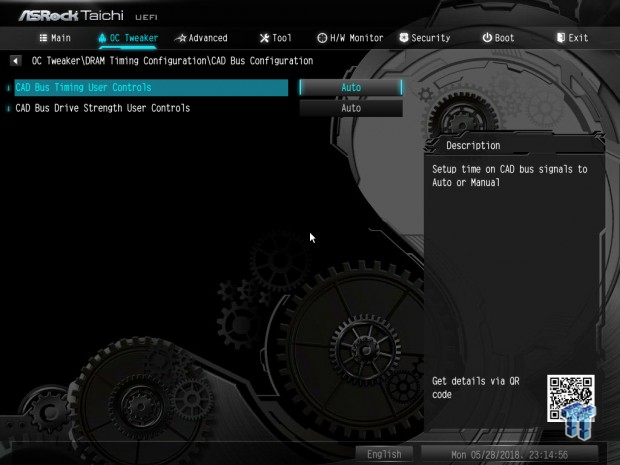
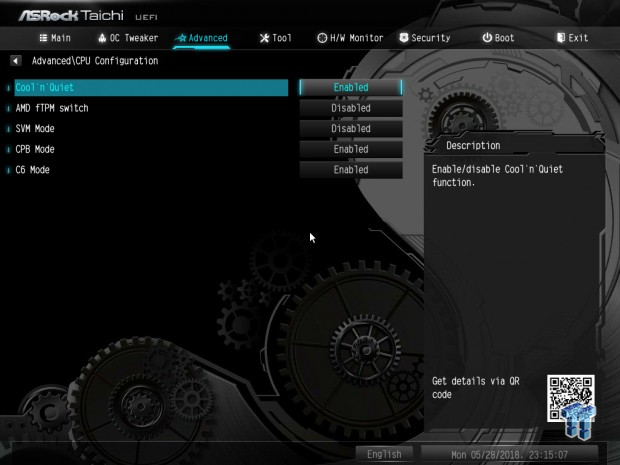
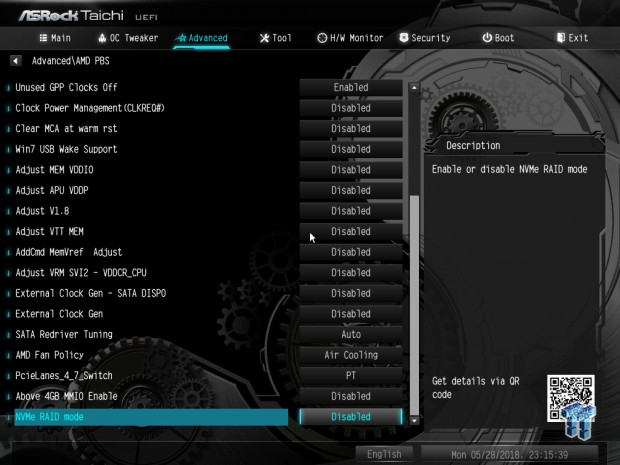
Software
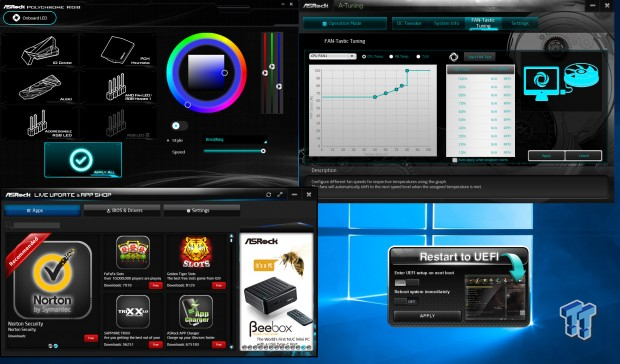
ASRock offers a lot of software including APP Shop, Restart to UEFI, Polychrome RGB, and A-Tuning.
Test System Setup
Steven's Motherboard Test System Specifications
- MotHeroboard: ASRock X470 Taichi
- CPU: AMD Ryzen 7 2700X
- Cooler: CoolerMaster MasterLiquid ML240R RGB - Buy from Amazon
- Memory: G.Skill Sniper (2x8GB) 3400MHz
- Video Card: NVIDIA GeForce GTX 1080 Ti - Buy from Amazon / Read our review
- Storage - Boot Drive: Kingston Predator 240GB
- Storage - SATA6G Drive: Micron Generic 240GB / Read our review
- Storage - USB Drive: Corsair Voyager GS 64GB - Buy from Amazon / Read our review
- Case: Corsair Obsidian 900D - Buy from Amazon / Read our review
- Power Supply: Corsair RM1000x - Buy from Amazon / Read our review
- OS: Microsoft Windows 10 - Buy from Amazon
- Monitor: ASUS PA328 ProArt 32" 4K - Buy from Amazon
- Keyboard: Corsair K70 LUX - Buy from Amazon
- Mouse: Corsair M65 PRO RGB - Buy from Amazon / Read our review
- Headset: Corsair VOID RGB Wireless - Buy from Amazon / Read our review
- Network: ASRock XG-U2008 10Gbit Switch
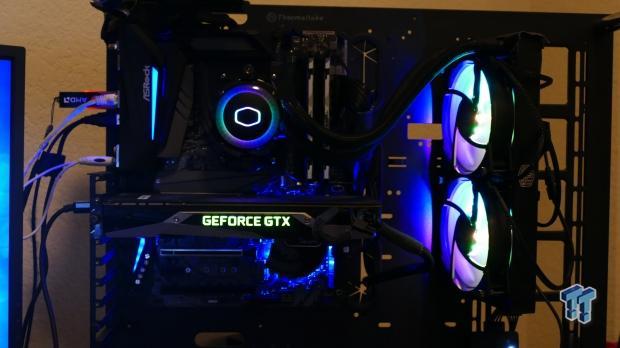
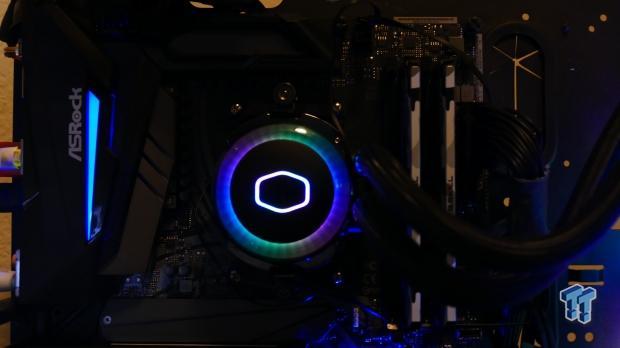
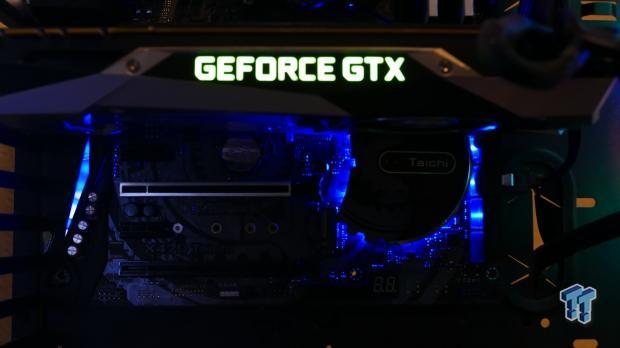
There are RGB LEDs built into the IO panel, audio area, and under the PCH. It goes together well with the CoolerMaster AIO pictured in the shots above.
Overclocking
Overclocking Results
CPU Overclocking
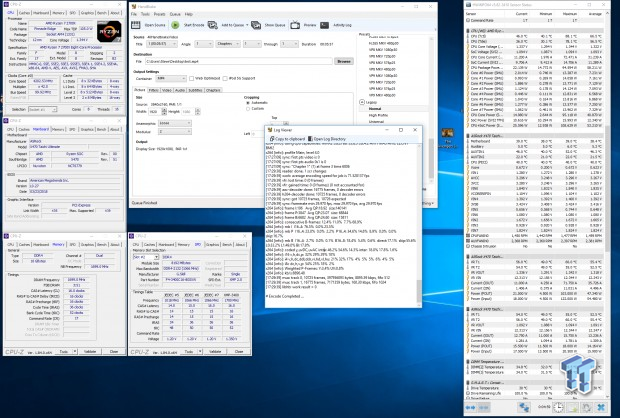
I used ASRock's default overclocking mode, set all cores to 42x and increased VCore to 1.35v. Setting XMP was super easy, and we hit our overclock with ease. The motherboard's high-end VRM helps facilitate easy overclocking.
CPU, Memory, and System Benchmarks
CINEBENCH R15
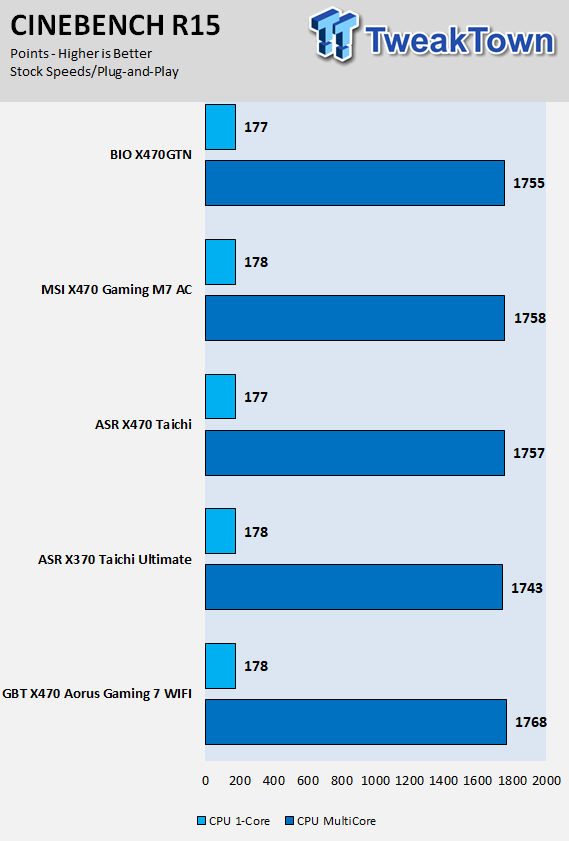
wPrime
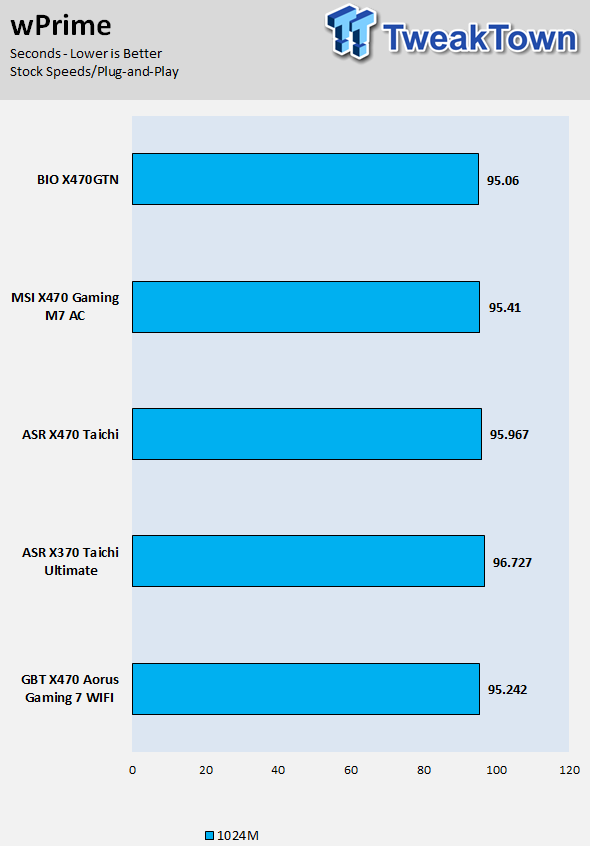
AIDA64 FPU
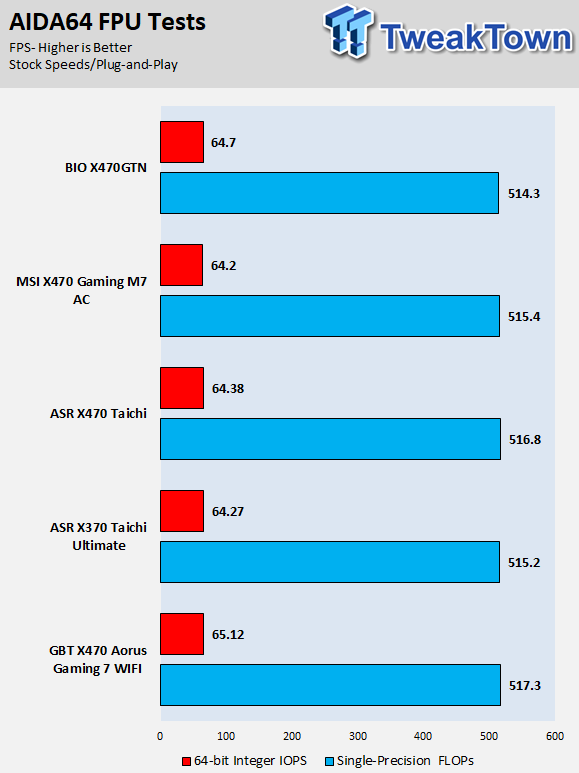
AIDA64 Memory
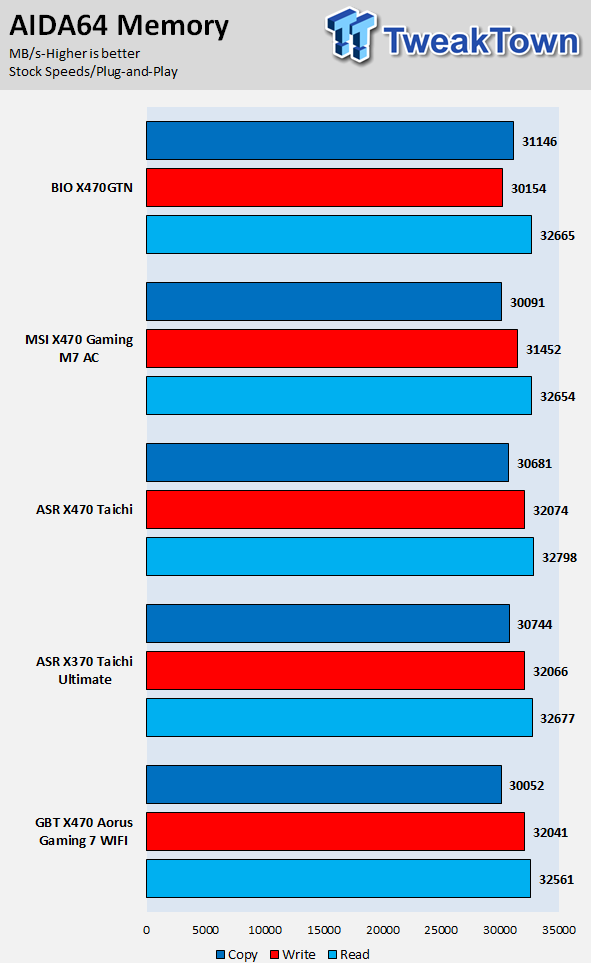
ScienceMark
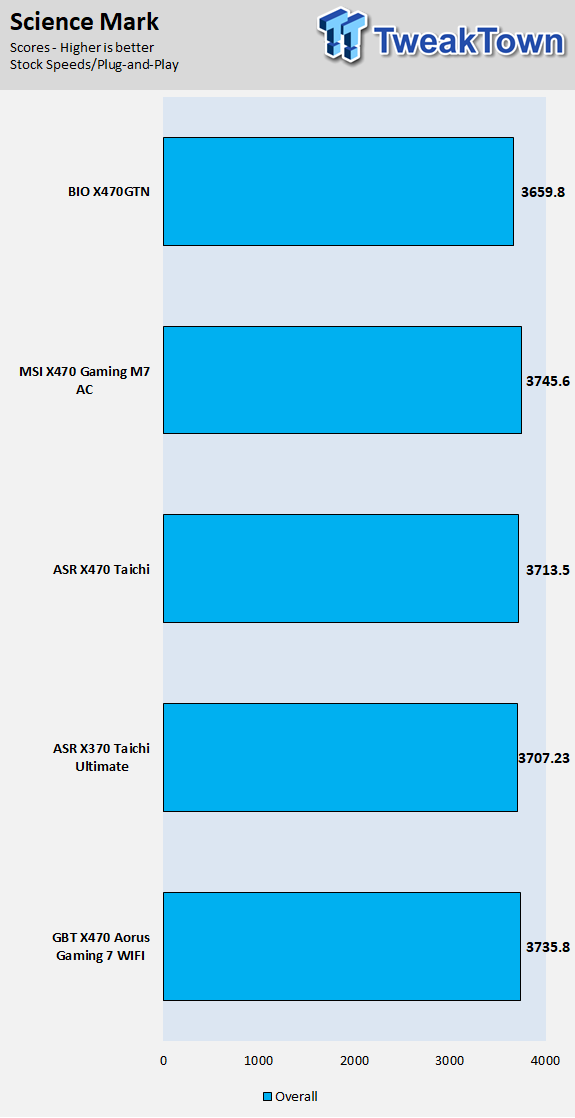
HandBrake
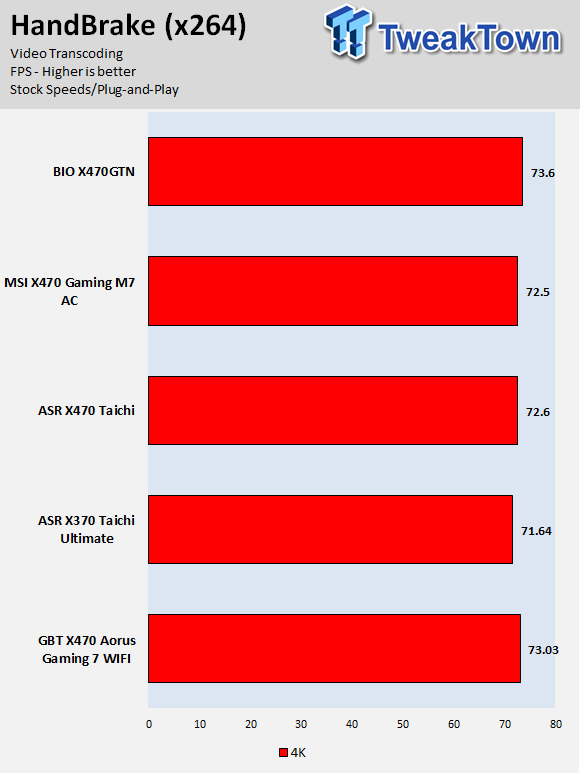
3DMark: Fire Strike
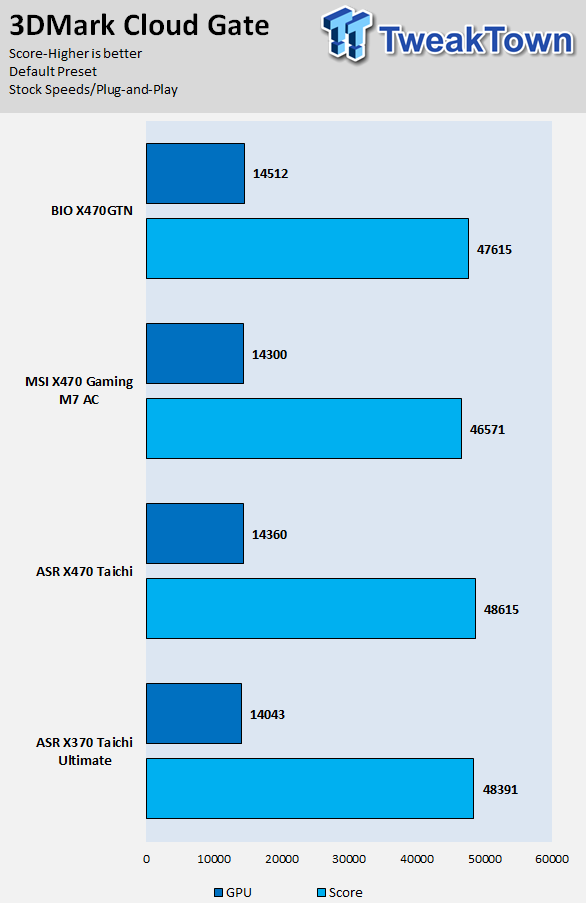
3DMark: Cloud Gate
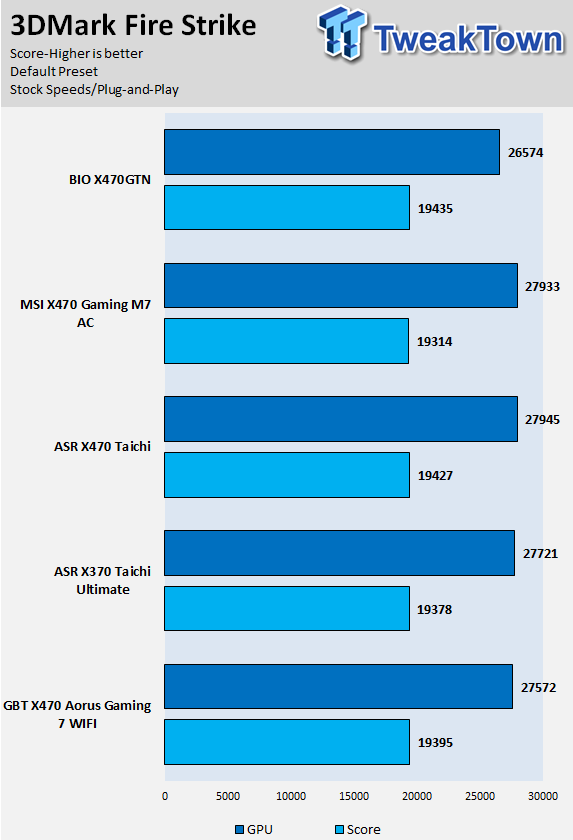
ResidentEvil 6
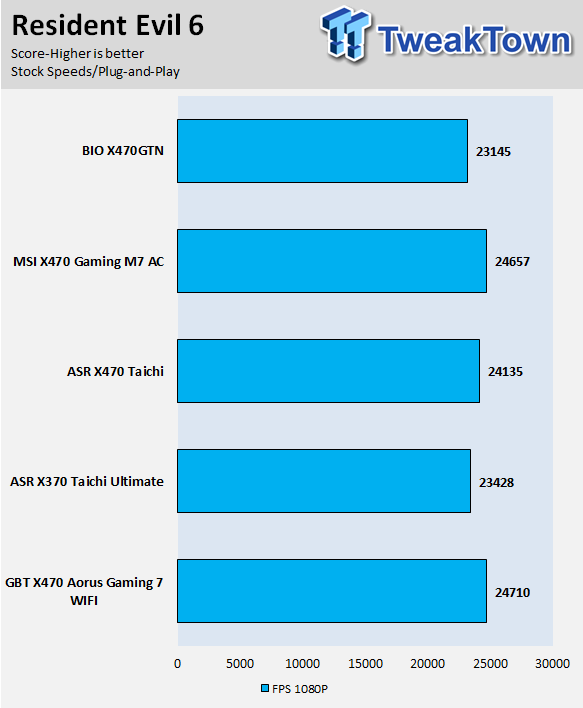
The X470 Taichi's performance is solid, and we found no performance issues. Most of the performance markers we see with these motherboards come from AMD's changes to their AGESA code.
System IO Benchmarks
CrystalDiskMark SATA6G:
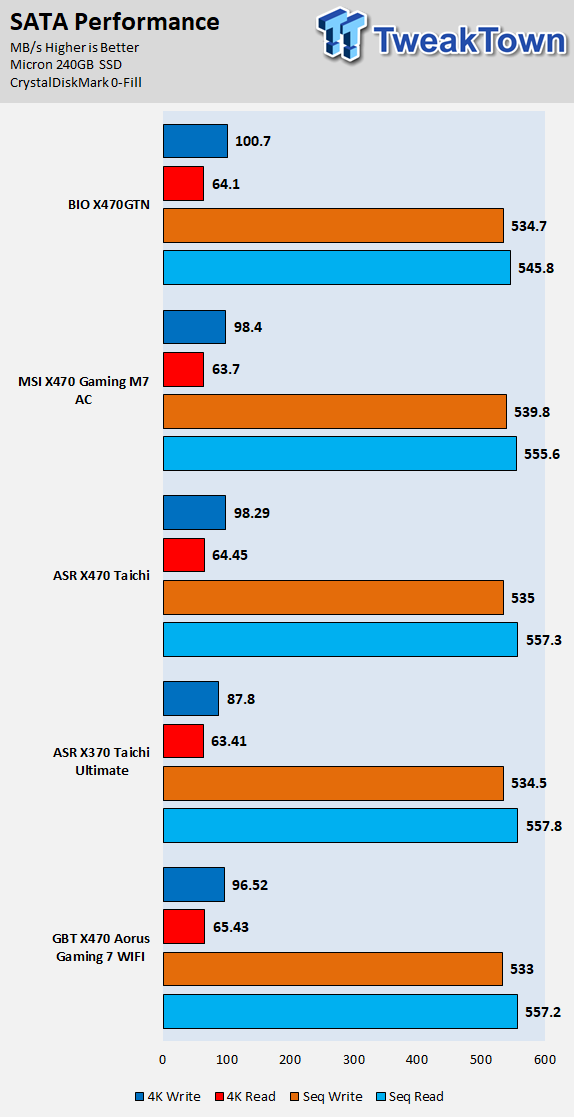
CrystalDiskMark M.2:
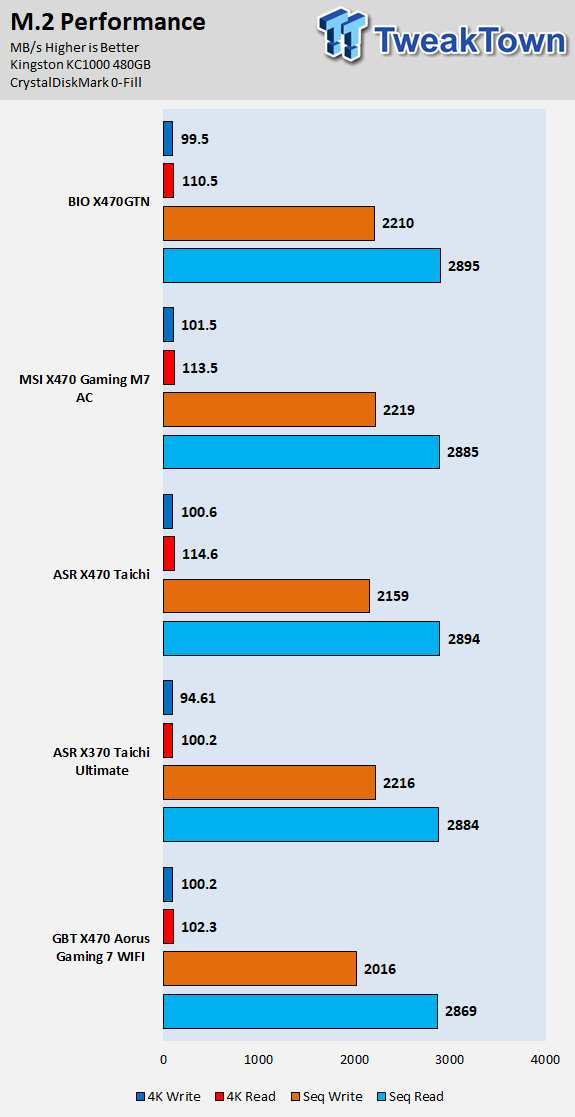
ixChariot Network Throughput:
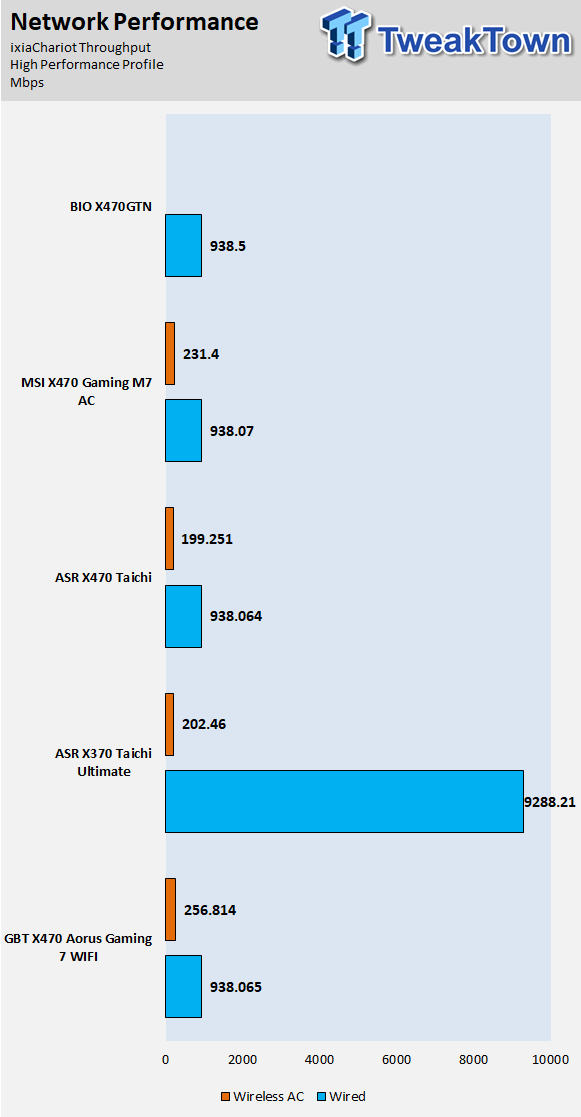
The X470 Taichi's storage and network performance are both excellent.
Audio RMAA 5.5:
I disable all audio features, set the correct bitrates, and then test the audio with a loopback test.
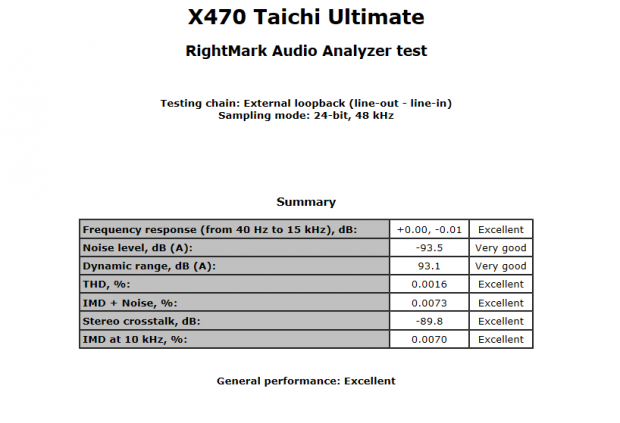
Sound Judgment by Ear: Excellent, ASRock tunes their audio quite well on their Taichi brand. There are five ratings for audio: 1. Problems, 2. Okay, 3. Acceptable, 4. Very good, 5. Excellent
Thermal Imaging and Power Consumption
System power is measured at the wall with an AC power meter.
Note on Thermal Images: In the temperature section, we use our Seek Thermal imaging camera to capture the surface temperatures of major components on the board. I look at the VRM and then all other things that light up the screen. If there is something to worry about, then I will state it. Otherwise, I will just show the hotter running parts of the board for fun. Unless some component is over 80-90C, then there isn't anything to worry about.
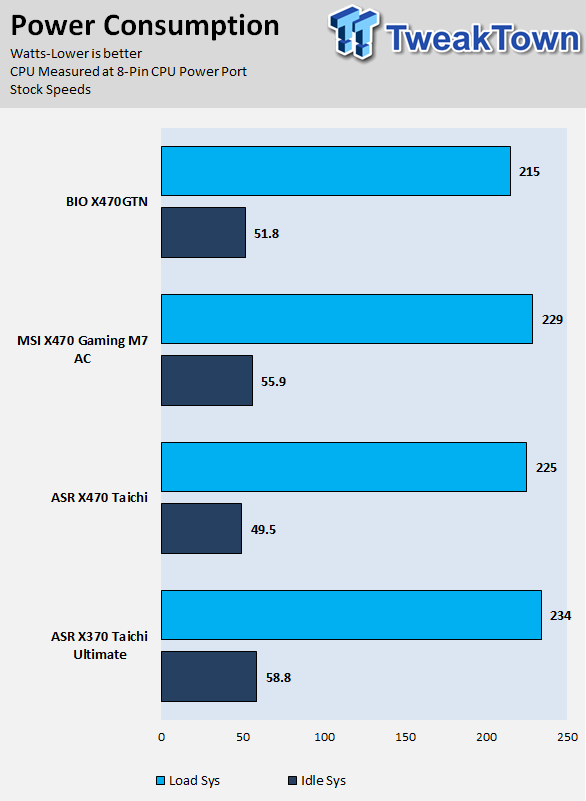
All systems will act differently, so I will look for commonalities, such as how far from the VRM the heat spreads through the PCB and the difference in temperature between the front side and backside of the PCB. Keep in mind, the majority of the heat from the VRM goes into the PCB as it is a giant soldered on copper heat sink. A larger difference in temperature between the back and front of the PCB points towards a more effective heat sink.
Thermal Testing at Stock Speeds:
The image on the left is always at idle, and the image on the right is at load. During ALL TESTS, fans above the VRM that cool the CPU cooler's (Corsair H110i) radiator are turned on to high (12v).
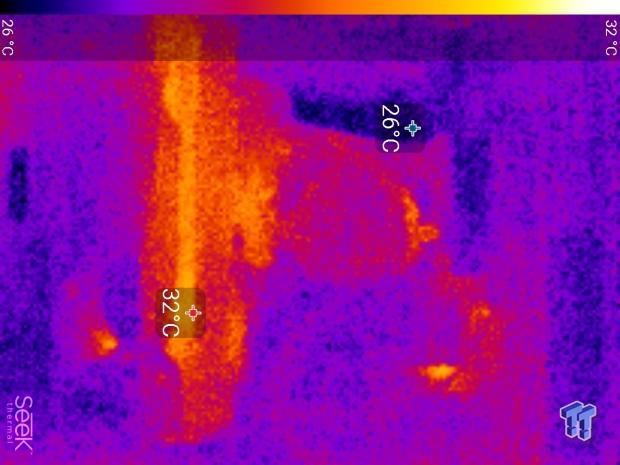
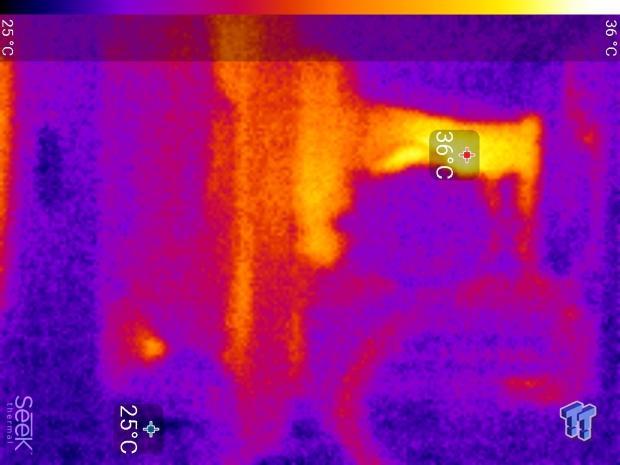
Full frontal.
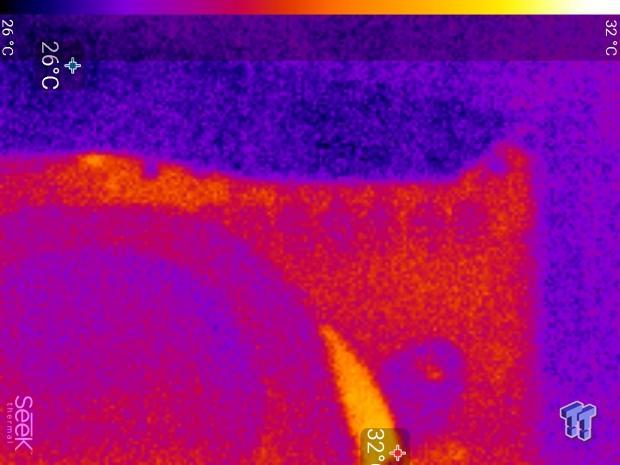
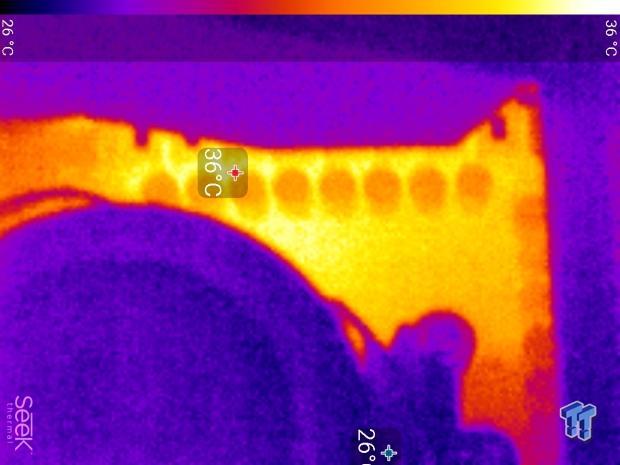
Up-close of the front of the VRM.
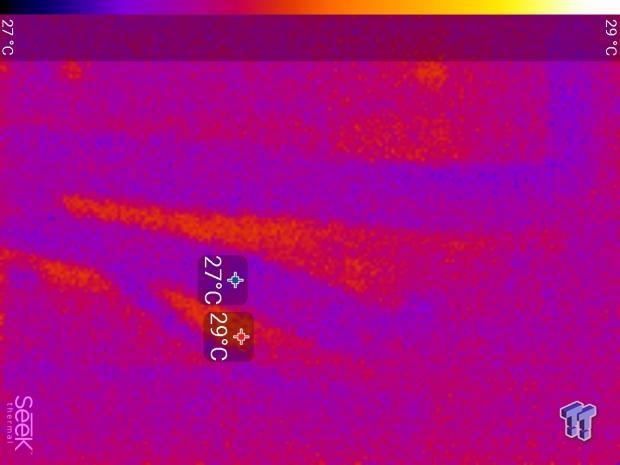
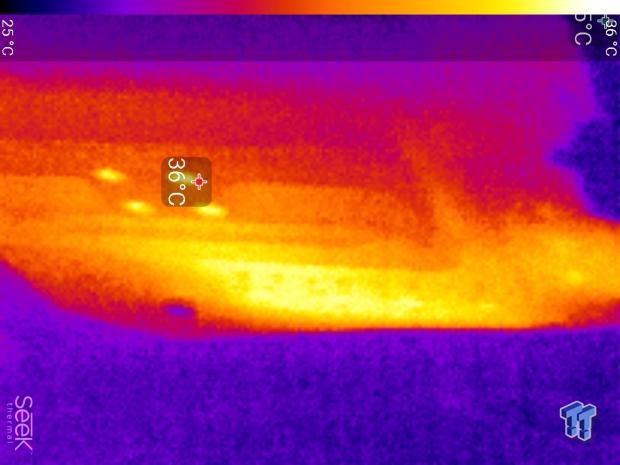
Up-close of the back of the VRM.
The X470 Taichi has an excellent VRM, even better than on the Taichi Ultimate because the 10G NIC isn't adding heat. Anything under 60C is great, 60-80C is acceptable, and anything above 80C is a bit worrisome (if at stock).
What's Hot, What's Not & Final Thoughts
What's Hot
VRM: The VRM on this motherboard is extremely well equipped for overclocking all Ryzen AM4 processors to their maximum. The inclusion of NexFETs and 60A inductors with a digital PWM control scheme results in an excellent VRM.
POST-Code Display: While ASRock removed some physical OC features such as power and reset buttons, they did leave the POST code display, which is one of the handiest tools one can have for diagnosing problems.
Ready for the future: We find dual M.2 slots, and the top one has a heat sink and is rated for x4 PCI-E 3.0. We also find rear and internal USB 3.1 (10Gb/s) ports, so your future devices will be supported. The motherboard also features a 256Mbit BIOS ROM so that the BIOS can be improved/expanded in the future.
What's Not
WIFI: The WIFI card is rated 1x1 for 433Mbps, but most other X470 motherboards offer 867Mbps or even higher.
Final Thoughts
The ASRock X470 Taichi is $60 less expensive than the Taichi Ultimate, and you only lose a few features, but one of those is a 10Gbit NIC. The inclusion of a 10Gbit NIC might be very important for some, but for others, it's a feature they might never make use of. If you look at a refresh cycle of an enthusiast, now might or might not be the right time for you to require a 10Gbit NIC.
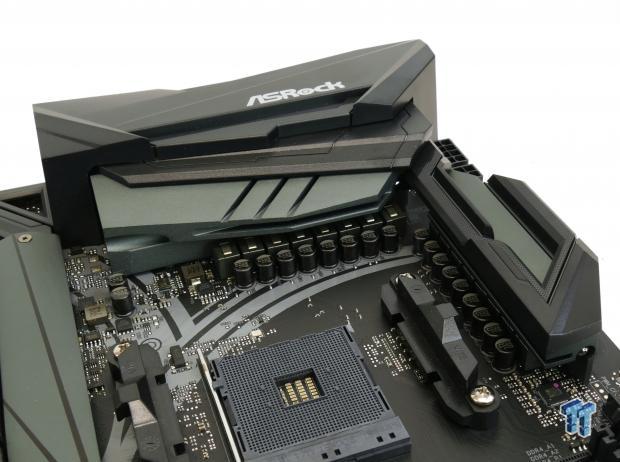
Now that WIFI speeds are exceeding that of a 1Gbit wired port, we are going to see more routers and switches come out with higher speed NICs that a 10Gbit NIC could take advantage of. However, that is not a certainty for all, and if you want a Taichi but don't need the high-end NIC, then stick with this model.

| Performance | 90% |
| Quality | 95% |
| Features | 92% |
| Value | 90% |
| Overall | 92% |
The Bottom Line: The ASRock X470 Taichi keeps levels of quality and features alive and well and is a great representation of its namesakes' reputation.
PRICING: You can find products similar to this one for sale below.
 United
States: Find other tech and computer products like this
over at Amazon.com
United
States: Find other tech and computer products like this
over at Amazon.com
 United
Kingdom: Find other tech and computer products like this
over at Amazon.co.uk
United
Kingdom: Find other tech and computer products like this
over at Amazon.co.uk
 Australia:
Find other tech and computer products like this over at Amazon.com.au
Australia:
Find other tech and computer products like this over at Amazon.com.au
 Canada:
Find other tech and computer products like this over at Amazon.ca
Canada:
Find other tech and computer products like this over at Amazon.ca
 Deutschland:
Finde andere Technik- und Computerprodukte wie dieses auf Amazon.de
Deutschland:
Finde andere Technik- und Computerprodukte wie dieses auf Amazon.de
Related Tags
